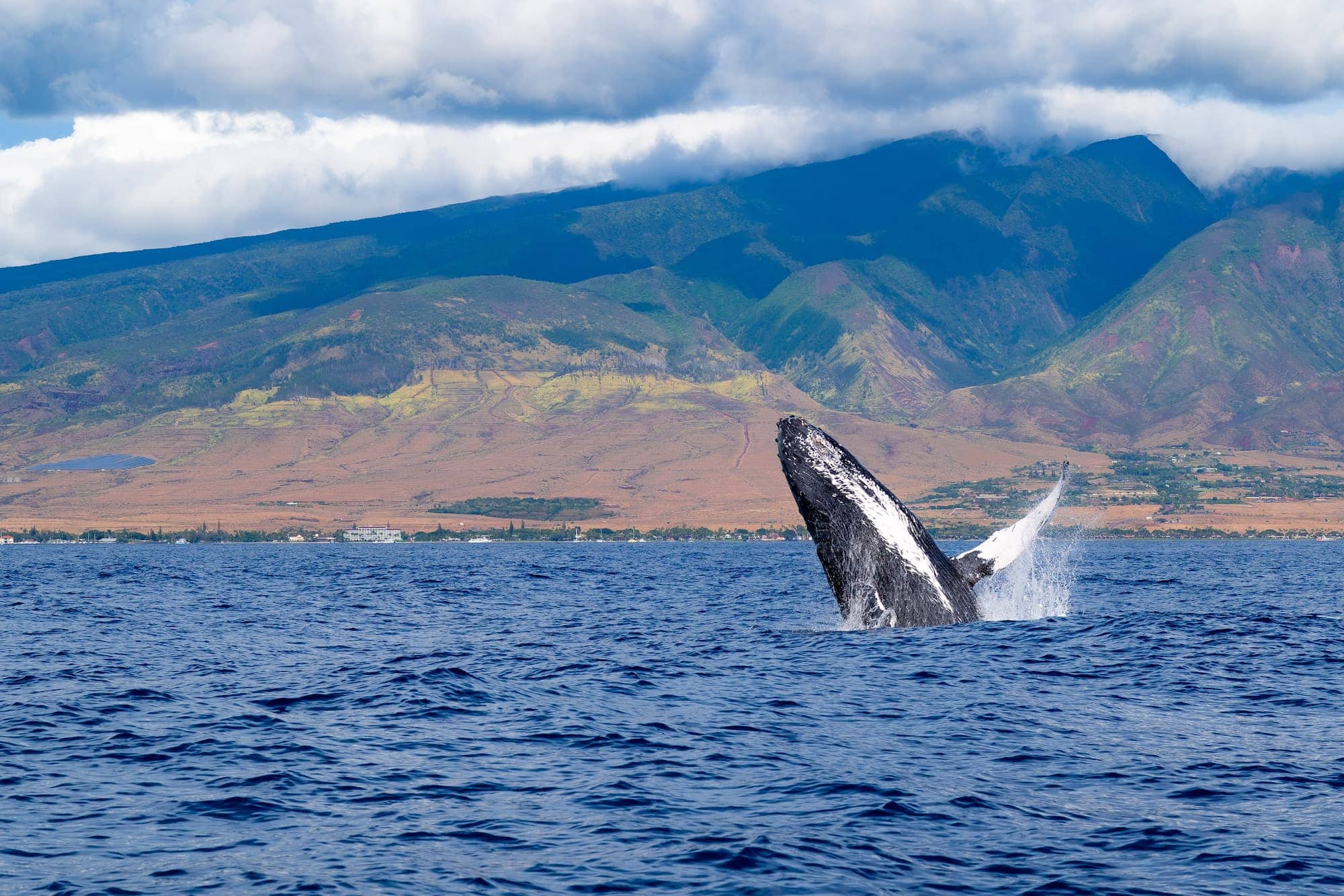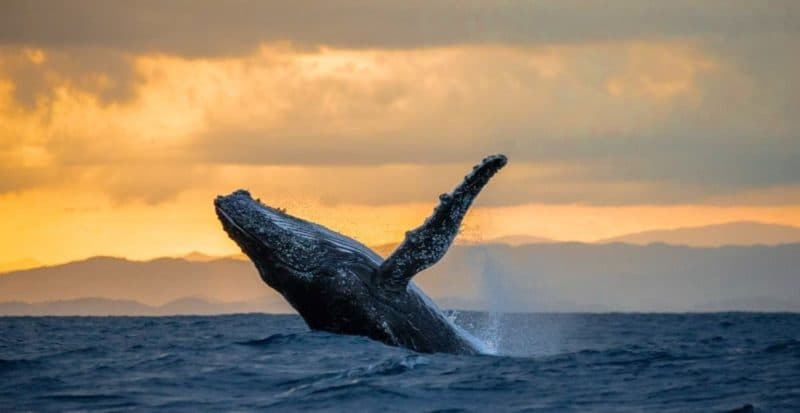Every year from November through April, more than 10,000 humpback whales migrate from Alaska to Hawaiʻi to give birth in its warm waters.
The whales can be found throughout the state, but one island stands out from the rest in terms of the number of whales that can be seen, the various ways to see them, and the consistency and regularity with which they can been seen.
Table of contents
- When is the best time to go Whale Watching?
- Why is Maui the Best island for Whale Watching?
- What’s the Best Way to See the Whales on Maui?
- Which Whale Watching Boat Tours on Maui Are Best?
- DIY Whale Watching tips: How to See and Experience the Whales Without a Tour
- Humpback Whale 101
Table of Contents
- When is the best time to go Whale Watching?
- Why is Maui the Best island for Whale Watching?
- What’s the Best Way to See the Whales on Maui?
- Which Whale Watching Boat Tours on Maui Are Best?
- DIY Whale Watching tips: How to See and Experience the Whales Without a Tour
- Humpback Whale 101
See the 15-minute video below to get an impression what it can be like to go whale watching. The video shows highlights from a 2022 whale watching excursion on Maui by @Dolphindronedom on YouTube.
Whale watching is seasonal – when is the best time to go?
The best time to go whale watching on Maui is during the winter months, between December and May. Maui is one of the best places to witness this annual migration, with an estimated 12,000 whales passing through the area each year. Peak whale watching season is typically from January to March, when the largest number of whales are present in the waters around Maui.
Saltwater Sail With the Whales on Maui
Maui is the place to see humpback whales! Set sail in the Hawaiian tradewinds and join the Captain and Crew in keeping a look out for humpback whales
from:
$85
What is a suggested tour?Our suggested tours are hand-picked tours that receive consistent good reviews, give back to the community, and work hard to minimize their impact on the environment. Read more about these tours on our website.It’s important to note that while the winter months are generally the best time to go whale watching on Maui, the exact timing of the whale migration can vary from year to year. Factors such as ocean temperatures and food availability can impact the timing and duration of the migration.
The best months for whale watching om Maui are summarized in the following table:
| Month | Probability of seeing whales |
|---|---|
| January | High |
| February | High |
| March | High |
| April | Medium (early April) to Low (late April) |
| May | Very low |
| June – October | No humpback whales in Hawaii :( |
| November | Low |
| December | Medium (whale watching tours start mid-December) |
Good to know: To increase your chances of seeing whales, it’s recommended to book a whale watching tour with a reputable company that has knowledgeable guides and access to the latest whale sighting information.
Why is Maui the Best Island for Whale Watching?
Maui is the best Hawaiian island for whale watching because the majority of the whales that visit Hawaiʻi end up hanging out in the shallow ʻAuʻau Channel that runs off its western shores.
During this time of year, whales can be seen consistently along the western and southern shores of Maui, performing memorable activities such as breaching, tail slapping, and breathing at the surface. On myriad boat tours, it is possible to learn more about the whale migration (who, what, where, when, why), to listen to their calls underwater via a hydrophone, and to get an up close and personal view of their behavior.
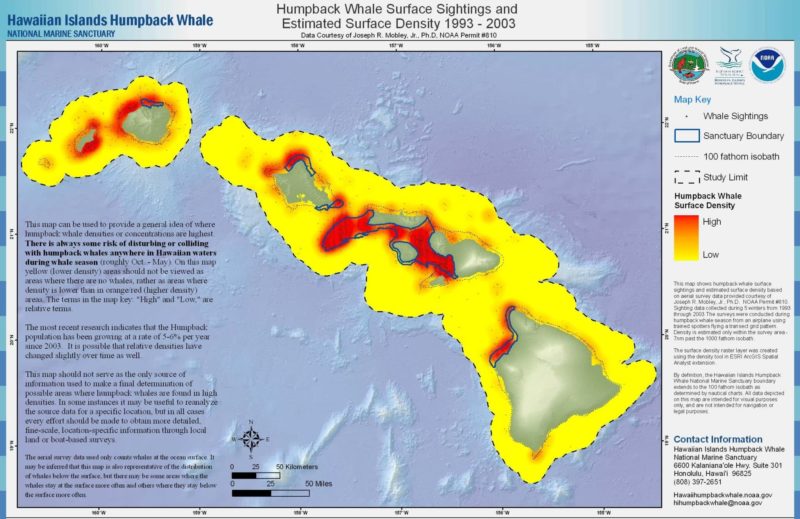
This map shows where you can best see humpback whales based on 10 years of sightings. The red zones are the best spots to see whales, the yellow zones also have whale sightings but relatively less. The aerial survey data was collected by Dr. Joe Mobley from UH during 1993 – 2003 and the density surface was developed by the Hawaiian Islands Humpback Whale National Marine Sanctuary
What’s the Best Way to See the Whales on Maui?
The best way to see the whales on Maui is to take a whale watching boat tour.
You can spot a lot of whales without leaving shore, just by sitting or standing in the correct spot (see details below); however, whale watching tours give you the best seat in the house with up-close encounters, professional narration, and views of Maui and the offshore islands from the water.
Which Whale Watching Boat Tours on Maui Are Best?
Which outfitter you choose depends a lot on what you are looking for in the experience. One of the most impactful choices to make is the size of the vessel.
Larger boats vs. Smaller boats. What’s the difference?
Which outfitter you choose depends a lot on what you are looking for in the experience. For example:
- Larger boats typically offer more services, like refreshments and bathrooms, and offer a better long-distance view and allow you to move around the vessel more freely. Larger boats are also more stable so are a great choice for people that are prone to feeling seasick.
- Smaller boats offer a more personalized, small-group experience but without extended services (like bathrooms or a bar). You are also closer to the water when whales show up, and should expect a bumpier ride.
Maui Whale Watching Tour recommendations
There are many types of whale watching tours on Maui, including bigger boats like the Pacific Whale Foundation, mid-sized sailing ships like Sail Maui (see below), and small-group experiences on pontoon boats such as Captain Steve’s Rafting.
Saltwater Sail With the Whales on Maui
Maui is the place to see humpback whales! Set sail in the Hawaiian tradewinds and join the Captain and Crew in keeping a look out for humpback whales
from:
$85
What is a suggested tour?Our suggested tours are hand-picked tours that receive consistent good reviews, give back to the community, and work hard to minimize their impact on the environment. Read more about these tours on our website.There are even kayak whale watching tours! See for example this kayak whale watching tour by Paddle On! Maui that departs from Wailea, or this 4-hour kayak whale watch departing from Kihei by Aloha Kayaks.
Before booking, ask yourself what services you need, and check the prices between the tours. If you’re looking for a recommendation from those in the whale industry, Whale Trust, a non-profit whale research organization, has a list of its approved vendors that provide good narration and practice appropriate on-water behavior.
Location, location, location
Regardless of which type of boat you choose, rest assured that all tours going out in the ʻAuʻau Channel (between Maui, Molokaʻi, and Lanai) will see whales, and that they all provide stunning views of Moloka‘i, Lāna‘i, Kaho‘olawe, and the Molokini Crater, as well as views from the boat looking back on Maui, the West Maui Mountains, and the 10,000-foot Haleakakā volcano.
The majority of tours leave from Lāhainā or Maʻalaea harbors on Maui’s west side.
DIY Whale Watching: How to See and Experience the Whales Without a Tour
On Maui, it is very easy to see whales from the shore, much easier than other islands due to the high concentration of whales that visit Maui. If you decide not to go on a boat tour, all you need to do is make sure you are looking in the right place. Remember, nearly all of the whales that visit Maui hang out on the west side in the ʻAuʻau Channel. So if you head to any of the Maui beaches in Wailea, Kīhei, or Lāhainā that border the channel, you will have a high chance of seeing whale activity offshore.
In addition to the channel-facing beaches, other great perches for whale watching include:
- Wailea Oceanside Path: This path winds its way along the cliffs that separate the resorts of Wailea. The slight elevation change is all you need for a good vantage point looking out into the channel.
- Kaʻanapali Beach Walking Path: This beach path is flat, but it is slightly raised above the shoreline, offering sweeping views of the channel and offshore islands.
- McGregor Point Lookout: This lookout is right around the corner from Maalaea and is a great place to spot whales from afar.
- Papawai Scenic Lookout: Right next to McGregor, this is another good lookout.
- Lāhainā Front Street: Anything you do along the west coast can be a whale watching activity during whale season. For example, want to wine and dine and whale watch? Pop into Front Street on Lāhainā and grab a seat at an oceanfront restaurant.
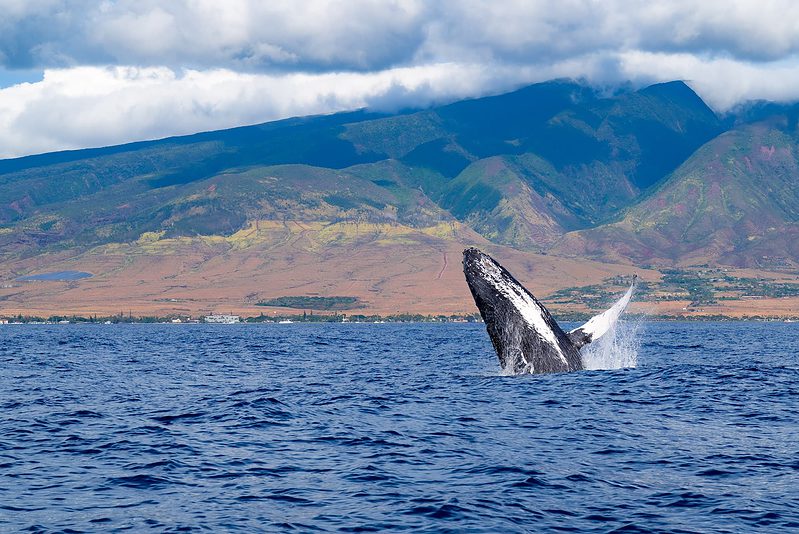
Humpback whale breaching off the west Maui coast. Photo by Steve Wrzeszczynski (website) on Unsplash
The Humpback Whale Sanctuary Visitor Center and the Maui Ocean Center
We also recommend visiting the Humpback Whale Sanctuary Visitor Center in Kīhei and the Maui Ocean Center. Both will provide more information about the whales as well as the most up to date information on whale sightings and activity. You can also volunteer to help count sightings through these organizations.
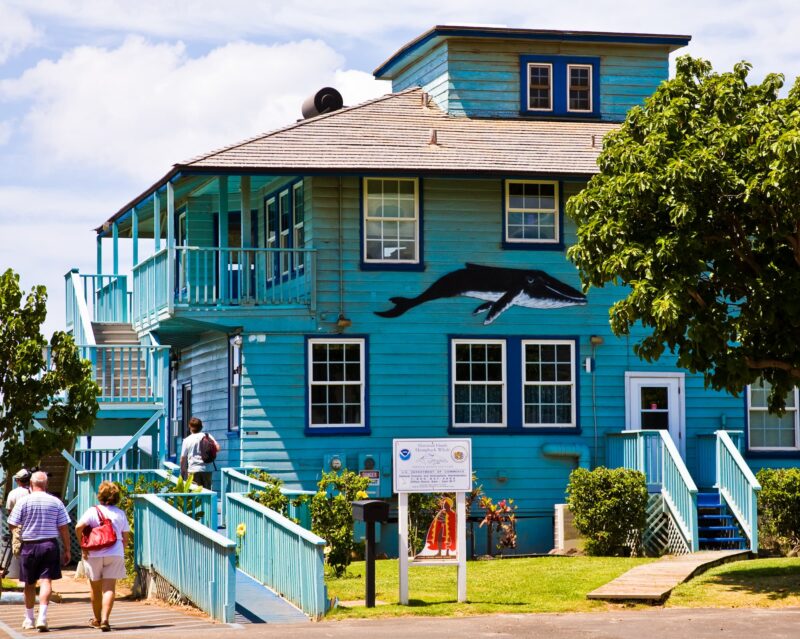
Located in Kīhei on the south shore of Maui, the visitor center is an ideal spot to learn about the marine environment and even see humpback whales breaching. Credit: Hawaii Tourism Authority (HTA) / Tor Johnson
What to Know About Whale Watching Season on Maui (Humpback Whale 101)
Whale season in Hawaiʻi generally starts in November and runs through the end of March, though it is possible to spot early arrivals in October and late departures in April.
The whales that come to Hawaiʻi are the humpback whales (Megaptera novaeangliae), and most are the size of a school bus. Once considered a food source, humpback whales were nearly hunted to extinction in the last century but have more recently been protected. In fact, Lāhainā was considered the capital of the whaling industry in the mid-19th century, and many whales were hunted out of the very same harbors that whale watching tours leave from today.
The humpback whales you will see in Hawai‘i make the 3,000-mile trip between Alaska, their feeding grounds, and Hawaiʻi, their birthing place, each year. You can learn more about theses whales in our humpback whale 101 guide, which goes into more detail.
